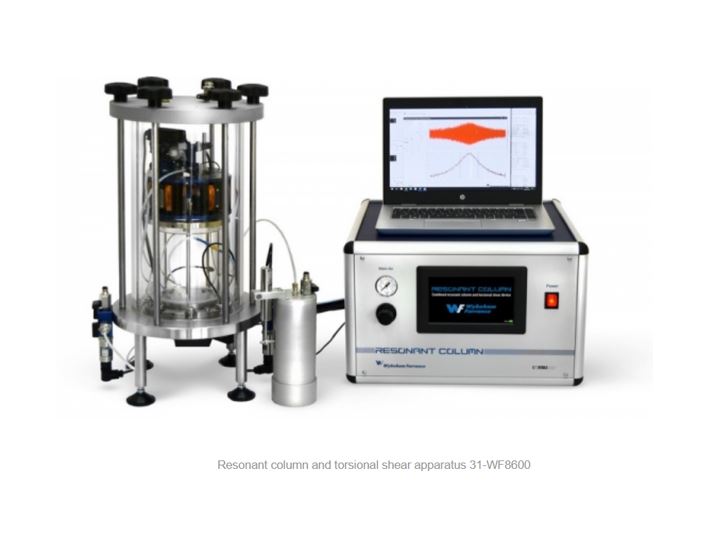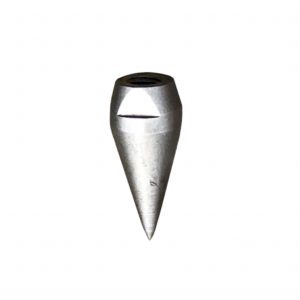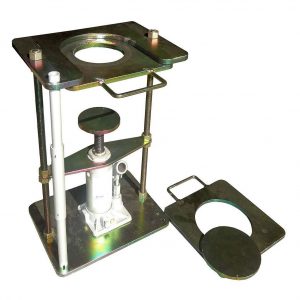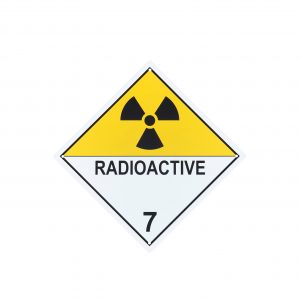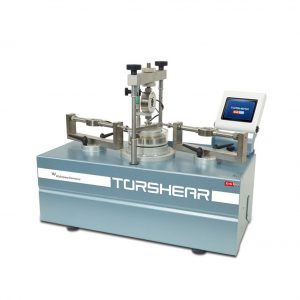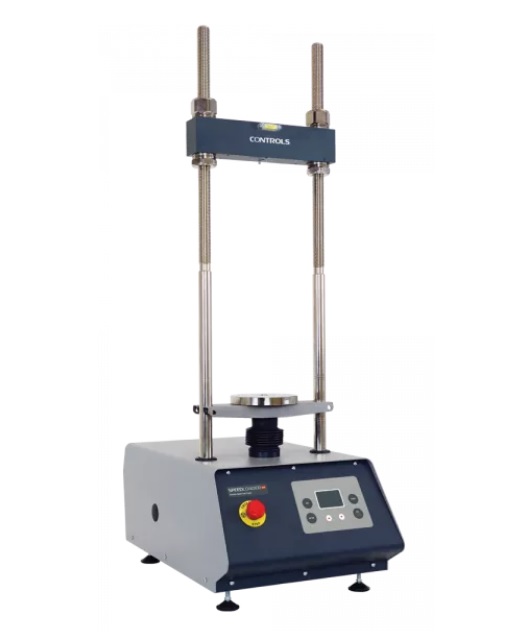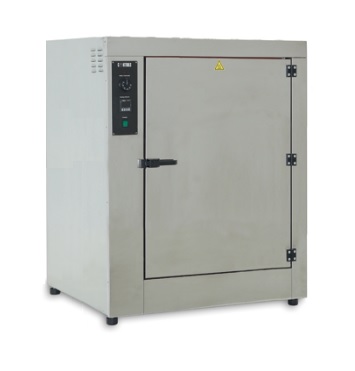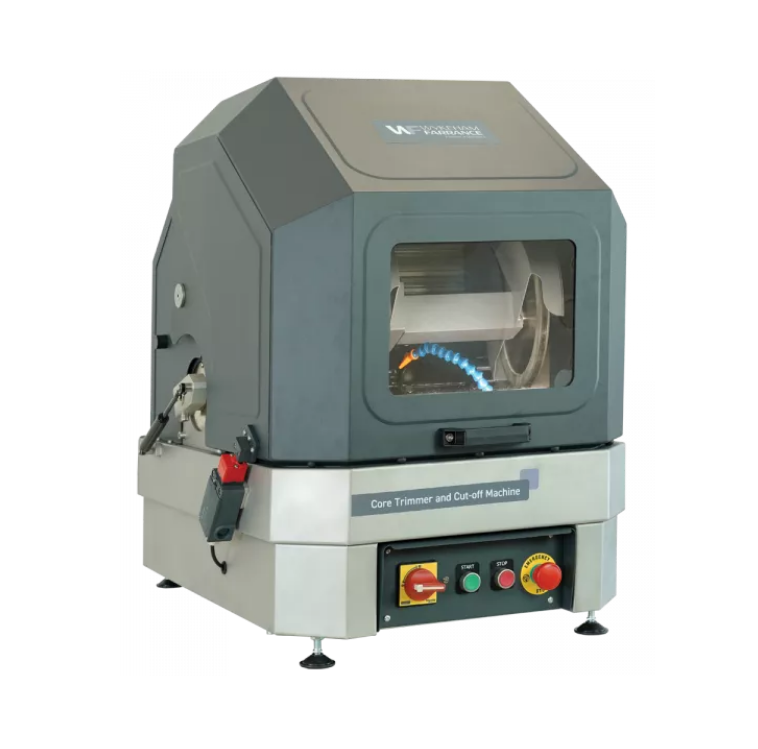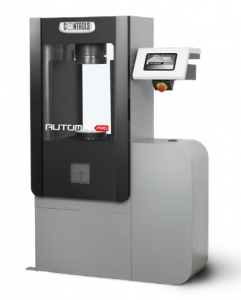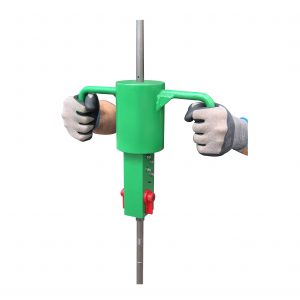Ordering Information
31-WF8600
Resonant Column — Combined resonant column and torsional shear device for the automatic determination of damping ratio from half power bandwidth and free vibration decay method.
110-220V, 60-50 Hz, 1 ph
Features:
– Maximum torque: 1.5 Nm
– Maximum angular deformation: 10°
– Maximum confining pressure: 1000 kPa
– Maximum sample size: 50 mm diameter x 110 mm height
The system includes:
– Stainless lower base cell with stainless steel columns and acrylic transparent cylinder (170mm internal diameter and 15mm thickness).
– Upper and lower drainage lines ensuring proper sample saturation
– Motor allowing large axial and angular deformation
– Motor support integral to the inner cylinder for easy assembly
– Integration of oscilloscope and function generator in the system data acquisition and control system ensuring consistency
– Two electro-pneumatic converters for cell and back pressure 1000 kPa.
– 10 channels signal conditioning and data recording
– Volume changes device with LVDT for measuring variation of volume
– LVDT for axial strain measurement
– Three pressure transducers for cell, pore and back pressure
– Two Eddy current displacement sensors with high precision motorized proximity sensors positioning
– Low MEMS accelerator
– Laptop PC complete with accessories and monitor
– Software to manage the test, time data acquisition and recording
The system generates a mechanical stress by the electromagnetic motor consisting of 8 coils and 4 magnets NeFeB with frequency range from 0 to 300HZ (for resonant column test) and from 0 to 50Hz (for torsional shear test).
Description
Versatile: Resonant column and cyclic torsional shear devices are combined into a single device allowing you to determine the following:
- RC: damping ratio from half power bandwidth, free vibration data and white noise
- TSS: damping ratio from hysteresis loops
Compact and easy-to-install: the cell consists of an outer cell and inner cell, both supporting the magnetic drive simultaneously. Connecting the laptop supplied to the compact unit, the user can to access all controls, power supply as well as electrical and pneumatic devices.
Robust design and long lasting: Sturdy construction minimizes losses and helps to deliver a consistent frequency response. The stainless steel base cell with acrylic transparent cylinder won’t rust or corrode, prolonging your equipment’s life.
User-friendly Graphic User Interface (GUI). The high quality laptop PC supplied with pre-installed intuitive Windows-based software allows you to perform various stages: saturation, isotropic consolidation, resonant frequency and torsional shear. The 7” color touchscreen with high resolution display makes cell, back and pore pressure easy to monitor.
Efficient and time-saving: The software uses the “Chirp Method” to continuously change the frequency applied to the sample. This method experiences no jumps when changing from one frequency to another improving strain measurement resolution and shortening testing time.
Easy saturation: additional upper drainage is included ensuring proper sample saturation.
High resolution and accuracy: Proximity transducers are mounted on the automated positioning system which automatically places them in the best measuring position after saturation and consolidation, eliminating the need for any manual adjustments during the test.
How it works
- A cylindrical soil specimen is restrained at the base and dynamically excited at the top by means of an electrical motor generating torsional forces via eight drive coils encircling four magnets attached to a drive plate at frequencies of up to 300 Hz
- The fundamental mode of vibration is determined from the maximum amplitude of motion. Following test standard ASTM D4015, resonant frequency, shear wave velocity and shear wave modulus are calculated using elasticity theory.
- The corresponding shear strain is evaluated from the motion amplitude. Material damping can be determined from the half-power bandwidth or from a free-vibration decay curve, which is generated by shutting off the driving power.
- In the Torsional Shear test, the soil specimen is deformed cyclically at a low frequency (a maximum of 10 Hz), whilst continuously monitoring torque and deformation.
- From the torque-deformation curves, a relationship between average shear stress and average shear strain is obtained, which in turn provides the shear modulus and the damping ratio.
The system consists of the following components:
TRIAXIAL CELL
Stainless steel cell with acrylic transparent cylinder with 170 mm int. dia. x 200 mm ext. dia., including
channels for bottom and top drainages; internal floating frame for assembling the electrical
motor that applies the torsional load. Test accessories for 50 mm (or 38 mm available on request)
diameter specimens.
N°2 calibration bars kit + n°1 calibration weight.
MAIN CONTROL BOX, LAPTOP PC AND SOFTWARE
Compact unit connected to laptop PC contains all control, power supply as well as electrical and pneumatic
devices. This system also contains air actuators (I/P converters) and amplification equipment.
High resolution 7” color touchscreen display for cell, and pore pressure monitoring.
SENSORS
The sensor kit contains: Axial LVDT transducer, Volume Change Apparatus, three pressure transducers,
two Eddy current displacement sensors with high precision motorized proximity sensors positioning,
low noise MEMS accelerometer.
The complete system includes a high-quality PC supplied with pre-installed intuitive Windows-based software that allows you to perform both Resonant Column and Torsional Shear tests. The test stages are as follows:
SATURATION
Ramped increase of cell and back pressure is applied causing the air to dissolve for a complete saturation of the specimen. All the pressure readings are shown in real time using an intuitive high resolution colour display.
ISOTROPIC CONSOLIDATION
The confining pressure is applied through the cell pressure until the soil is consolidated, i.e. when pore pressure is dissipated, and volume change is negligible. The soil specimen is restrained at the bottom and dynamically excited at the top.
RESONANT FREQUENCY
Frequencies up to 300 Hz are increased automatically in “steady-state” mode by steps (RC discrete) or continuously (RC chirp), or in “free-decay” mode by only an initial frequency. Since the frequency of the input signal varies, the dynamic response of the specimen results in a varying motion amplitude. The secant shear modulus G is determined by the resonant frequency.
The damping ratio D can be evaluated with two methods:
- In the frequency domain, from the complete frequency response of the soil specimen (half-power bandwidth)
- In the time domain, from free-vibration decay curve that is generated by shutting off the driving power (logarithmic decrement method).
TORSIONAL SHEAR
The technique used is the input torsional rotation through a sinusoidal current applied to the coils.
Cyclic torque application in Torsional shear.
Technical Specs
- Maximum torque: 1.5 Nm
- Maximum angular deformation: 10°
- Maximum cell and back pressure: 1 MPa.
- 10 channels signal conditioning unit
- USB data acquisition and signal generation board
- Two electro-pneumatic converters for cell and back pressure
- Excitation frequency: Dynamic (RC) 1-300 Hz; Cyclic (TS) from 0 to 50 Hz maximum
- Dimension: Control Box 51×45 x 35 cm (h x w x d); Cell 55 cm x 27 cm (h x diam.)
- Weight: approx. 50 kg


